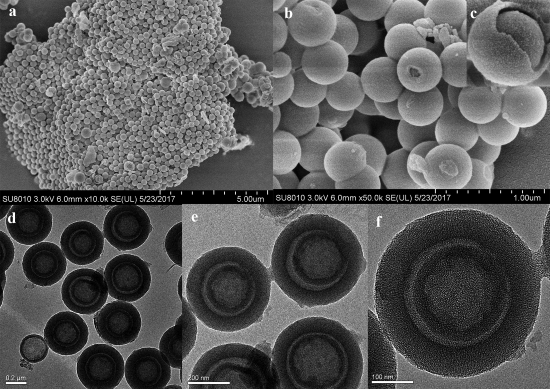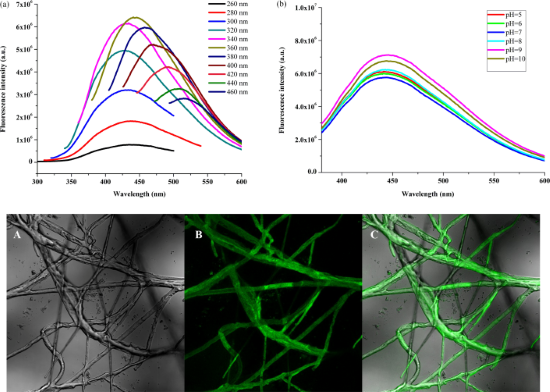Fluorophore-free luminescent double-shelled hollow mesoporous silica nanoparticles as pesticide delivery vehicles
With the rapid development of nanoscience and nanotechnology in recent years, smart nano-delivery systems of pesticides have showed great potential to address some challenges that modern pesticides have faced. Although large progress has been made on the application of mesoporous silica nanoparticles (MSNs) as pesticide carriers, multifunctional MSNs endowed with bright luminescent centers to facilitate the tracking of MSNs in biological systems and versatile structural properties possessing a high drug loading capacity and adjustable release are still highly desirable. Recently, a research group at the Key Laboratory of Integrated Pest Management in Crops, Institute of Plant Protection, CAAS (IPP-CAAS) published a research paper on Nanoscale (2018, 10: 20354–20365), reporting the preparation of fluorophore-free luminescent double-shelled hollow MSNs (F-DSH-MSNs) by a selective-etching strategy and subsequent annealing treatment. The strong and stable luminescence was detected to originate from the carbon dots generated from the calcination.

Schematic illustration of the preparation of F-DSH-MSNs
The as-synthesized F-DSH-MSNs nanoparticles exhibited a well-separated monodispersed spherical morphology with a smooth surface and an average particle size of about 410 nm revealed by SEM and TEM observations. The F-DSH-MSNs had maximum emission intensity at 441 nm with an excitation of 360 nm. High luminescence intensities were maintained without drastic changes over the pH range of 5–10, confirming that F-DSH-MSNs were suitably used over a wide pH region. F-DSH-MSNs were inert against fluorescence attenuation and exhibited long-term stability, which were particularly suitable for in vivo optical imaging. Mycelia of P. asparagi treated with pesticide loaded F-DSH-MSNs exhibited strong fluorescence under a laser excitation wavelength of 405 nm.
These versatile silica nanoparticles served as a novel delivery system for the pesticide pyraclostrobin with a loading content of 28.5%. When studied in a release medium composed of PBS solution (pH = 7), ethanol and Tween-80 emulsifier (80:19.5:0.5, v/v/v), an initial burst release followed by a slow, sustained release profile was observed. The initial burst release satisfied the needs for immediate treatment after application. The followed sustained releases could provide persistent bioactivity.


Emission spectra of F-DSH-MSNs as well as confocal imaging of P. asparagi mycelia treated with pesticide loaded F-DSH-MSNs
The fungicidal activity of pyraclostrobin loaded F-DSH-MSNs (Py@F-DSH-MSNs) against P. asparagi was determined by the mycelium growth rate method. When the concentration of the active ingredient reached 0.2 mg/L, the percentage of inhibition (%) was more than 90% on the fourth day. To demonstrate the applicability, the bioactivity of Py@F-DSH-MSNs against cucumber powdery mildew was evaluated using a pot experiment. Results indicated that the developed novel silica nanoparticles can serve as a versatile carrier to deliver pesticides to pathogens for plant protection.
More details are available on the bellow links:
https://pubs.rsc.org/en/content/articlelanding/2018/nr/c8nr04626c#!divAbstract
By Cao Lidong (caolidong@caas.cn)
-
 Apr 18, 2024Opening Ceremony of the Training Workshop on Wheat Head Scab Resistance Breeding and Pest Control in Africa Held in CAAS
Apr 18, 2024Opening Ceremony of the Training Workshop on Wheat Head Scab Resistance Breeding and Pest Control in Africa Held in CAAS -
 Apr 03, 2024IPPCAAS Co-organized the Training Workshop on Management and Application of Biopesticides in Nepal
Apr 03, 2024IPPCAAS Co-organized the Training Workshop on Management and Application of Biopesticides in Nepal -
 Mar 28, 2024Delegation from the School of Agriculture and Food Science of University College Dublin, Ireland Visit to IAS, CAAS
Mar 28, 2024Delegation from the School of Agriculture and Food Science of University College Dublin, Ireland Visit to IAS, CAAS -
 Mar 25, 2024Director of World Food Prize Foundation visited GSCAAS
Mar 25, 2024Director of World Food Prize Foundation visited GSCAAS -
 Mar 20, 2024Institute of Crop Sciences (ICS) and Syngenta Group Global Seeds Advance Collaborative Research in the Seed Industry
Mar 20, 2024Institute of Crop Sciences (ICS) and Syngenta Group Global Seeds Advance Collaborative Research in the Seed Industry
